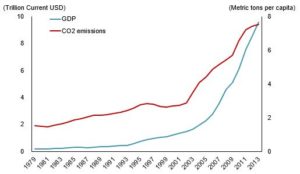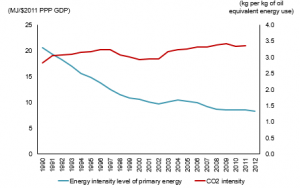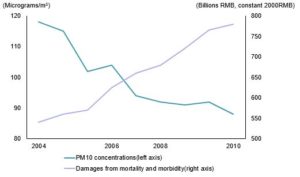Who is concerned
-
Executives in a heavy industry sector
-
Investors in the medical industry
-
Investors in green and renewable energies
-
And, generally speaking, anyone who seeks to better understand the issue.
In a nutshell
The prevailing wisdom tells us that China would not be able to grow so fast without high levels of pollution. Is this truly the case? The reality is nuanced and full of surprises.
Details:
At first glance, the link between China’s pollution and its GDP growth appears clear:
China CO2 Emissions and GDP
(1979 – 2013)

However closer investigation shows a more nuanced picture.
To begin with, it turns out that China’s energy-to-GDP intensity is in fact decreasing, and has been for a while. It is the carbon-to-energy intensity that is increasing. This is, in principle, a fixable problem, based on the experience of several countries.
China Energy Intensity Level of Primary Energy and CO2 Intensity
(1990 – 2012)
(1990 – 2012)

Furthermore, it turns out that air pollution is declining. So does this mean that people are wrong to be talking so much about it?
No, because – surprise again – even as pollution decreases, mortality caused by pollution is increasing. This is caused by increasing urbanization.
The following graph illustrates the decline in pollution, and the increasing cost of pollution on the economy. This cost, as of 2010, stood at 1.9% of GDP.
Particulate Matter Pollution and Estimated Health Damages In Urban China
(2004 – 2010)
(2004 – 2010)

Yes, pollution does have a direct economic cost. Yet on the face of it, this cost is less than the contribution of the polluting industries to GDP.
Yet – surprise again – a closer look reveals a more nuanced picture. Consider the following:
- The most polluting companies are precisely the ones that are too small to be economically efficient. Many of them are among the companies being driven into insolvency by the current tough economy.
- There is a massive amount of unused renewable energy capacity in China, sitting idle. It has been crowded out of the grid for a number of reasons, among which that municipalities do not want harm to their local coal power producers. This is a form of economic subsidy. (There are other reasons, for example renewable energy capacity built too far from the demand, or renewable energy capacity that is not stable enough to rely on.)
The bottom line about pollution in China is that there is no bottom line. It is an area full of surprises.
What to do about it
-
Executives in a heavy industry sector: expect that the central government will address this issue not only due to the social outcry, but also due to the economic impact. Expect the central government to move slowly, but nonetheless to move decisively.
-
Investors in the medical industry: unfortunately, this issue opens up a very large market.
-
Investors in green and renewable energies: expect that government movement on this issue will be slower than you would like. Municipalities will in many instances resist, and the government will not want to cause economic disruption due to moving too fast.